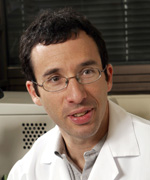Colleagues: Recently Tenured
HEATHER CAMERON, PH.D., NIMH
Senior Investigator; Chief, Section on Neuroplasticity

Education: Yale University, New Haven, Conn. (B.S. in biology); Rockefeller University, New York (Ph.D. in neuroscience)
Training: Postdoctoral training at NINDS
Came to NIH: In 1995 for training; became tenure-track investigator in 2001
Selected professional activities: Associate editor, Journal of Neuroscience; editorial board, PLOS Biology
Outside interests: Badgering her three kids to do their homework
Web sites: https://irp.nih.gov/pi/heather-cameron; http://neuroscience.nih.gov/Lab.asp?Org_ID=411
Research interests: My laboratory studies adult neurogenesis in the hippocampus, one of only two brain areas that add large numbers of new neurons during adulthood. (The other brain area is the olfactory bulb.) We have studied the regulation of hippocampal adult neurogenesis for several years, but we are now focusing more on understanding the effect of these new neurons on the brain and behavior. It seems likely, based on their location in the hippocampus, that the function of new neurons is related to learning and memory.
However, a growing body of evidence suggests that new neurons may play a role in depression. Because memory deficits are not a primary symptom of depression, and other conditions are more strongly associated with memory loss, it is unclear how these two potential roles for new neurons might fit together.
We have found that adult mice lacking neurogenesis show prolonged responses to stressful experiences and show increased depressive-like behavior after stress. We are interested in understanding how the new neurons affect the stress response and how their stress-buffering property relates to roles for adult neurogenesis in learning and memory and in mood disorders.
HONGLEI CHEN, M.D., PH.D., NIEHS
Principal Investigator, Aging and Neuroepidemiology Group, Epidemiology Branch

Education: Tianjin Medical University, China (M.D.); Chinese Academy of Preventive Medicine, Beijing (M.Sc. in nutritional epidemiology); Tufts University, Boston (Ph.D. in nutritional epidemiology)
Training: Research associate, Harvard School of Public Health (Boston)
Before coming to NIH: Instructor, Harvard School of Public Health (Boston)
Came to NIH: In 2005 as a tenure-track investigator
Selected professional activities: Associate editor for the American Journal of Epidemiology; associate editorial boards for the American Journal of Neurodegenerative Disease and the International Journal of Molecular Epidemiology and Genetics; adjunct associate professor, Department of Epidemiology, University of North Carolina at Chapel Hill, N.C.
Outside Interests: Hiking; playing soccer
Web site: https://irp.nih.gov/pi/honglei-chen
Research Interests: My group is interested in understanding the genetic and environmental factors that contribute to Parkinson disease, a neurodegenerative disorder that affects more than one million older adults in the United States. The symptoms vary, but the primary ones are tremor, or trembling in hands, arms, legs, jaw, and face; rigidity, or stiffness of the limbs and trunk; bradykinesia, or slowness of movement; and postural instability, or impaired balance and coordination. Over the past several years, my group and my collaborators have reported that moderate to vigorous exercise, ibuprofen use, higher plasma urate, and longer duration (rather than intensity) of smoking were all associated with a lower risk of Parkinson disease. As a member of an international Parkinson consortium, we’ve also identified genes that contribute to late-onset Parkinson disease.
Parkinson patients also suffer from a variety of nonmotor manifestations that may precede the onset of motor symptoms. To this end, my collaborators and I have reported that depression, anxiety, daytime sleepiness, constipation, weight loss, and erectile dysfunction were associated with a future risk of developing Parkinson disease. We hope to further this work by evaluating how these nonmotor symptoms, alone or in combination, relate to a Parkinson diagnosis and how environment and genetic factors may alter the development of the disease.
MICHAEL FESSLER, M.D., NIEHS
Senior Investigator, Clinical Investigation of Host Defense Group, Laboratory of Respiratory Biology

Education: Princeton University, Princeton, N.J. (B.A. in philosophy); Harvard Medical School, Boston (M.D.)
Training: Residency in internal medicine, Massachusetts General Hospital (Boston); fellowship in pulmonary sciences and critical care medicine, University of Colorado Health Science Center (Denver)
Before coming to NIH: Assistant professor of medicine, National Jewish Medical and Research Center (Denver)
Came to NIH: In 2006 as a tenure-track investigator
Selected professional activities: Editorial board for PLOS ONE; faculty member of the Faculty of 1000 Medicine; member of American Thoracic Society and NIH Translational Research Interest Group
Outside interests: Running; playing tennis
Web site: https://irp.nih.gov/pi/michael-fessler
Research interests: My group studies the role of cholesterol in innate immunity, the hard-wired arm of the immune system that responds to infection, tissue injury, and other environmental stresses. We use genetically modified mouse models, lipid-raft analysis, targeted proteomic analyses, and signal-transduction approaches to define how cholesterol-trafficking mechanisms regulate the innate immune response. Our ultimate objective is to define novel molecular targets that intervene in human immunity.
Several of the studies we conduct are translational in design; we use primary human leukocytes collected from blood donors in the NIEHS Clinical Research Unit. Partnered with mouse models and insights garnered from molecular epidemiology, these studies aim to define the biology of infection and inflammation in the human lung in a way that may ultimately inform the diagnosis and care of patients with pneumonia, asthma, and a variety of environmental lung diseases.
WEI LI, PH.D., NEI
Senior Investigator and Chief, Retinal Neurobiology Section

Education: Zhejiang University School of Medicine, Hangzhou, China (B.M. in clinical medicine); University of Texas at Houston (Ph.D. in neuroscience)
Training: Postdoctoral training at Northwestern University Feinberg School of Medicine (Chicago)
Came to NIH: In 2007 as a principal investigator in NEI
Selected professional activities: Member of the Association for Research in Vision and Ophthalmology and of its Annual Meeting Planning Committee; member of the Society for Neuroscience
Outside interests: Traveling; cooking; playing sports (tennis, skiing, and running); spending time with his son
Web site: https://irp.nih.gov/pi/wei-li
Research interests: The Retinal Neurobiology Section studies the structure and function of retinal synapses and circuits. We are trying to understand how retinal neurons interact via synapses and how a network of these interactions, in the form of a neural circuit, transmits visual information. Such knowledge is vital for understanding the mechanisms of visual processing that are linked to information processing in the brain. This knowledge will also establish a foundation for understanding synaptic loss and dysfunction in retinal diseases and determining how to therapeutically rescue them. The retina is one of the most promising central-nervous-system areas that can be functionally mapped, thanks to its unique two-dimensional-like structure as well as to our knowledge of neuronal morphology and use of diverse techniques to assess neuronal function.
A second interest of our section is to understand how the retina adapts to extreme metabolic conditions such as those experienced by hibernating animals. We believe that metabolism is one of the core issues pertaining to the health and pathological change in the retina. By studying hibernating animals, we hope to identify strategies that can help the retina better cope with metabolic stresses that occur in retinal disease.
JOSHUA MILNER, M.D., S.B., NIAID
Senior Investigator, Allergic Inflammation Unit, Laboratory of Allergic Diseases

Education: Massachusetts Institute of Technology, Boston (S.B. in biology); Albert Einstein College of Medicine, New York (M.D.)
Training: Residency in pediatrics at Children’s National Medical Center (Washington, D.C.); clinical fellowship in allergy and immunology at NIAID
Came to NIH: In 2003 for training; in 2008 entered the NIAID Clinical Research Transition Program; in 2009 was named chief of NIAID’s Allergic Inflammation Unit as a tenure-track investigator
Selected professional activities: Councilor, Clinical Immunology Society
Outside interests: Playing hand drums; singing; produced a CD of Jewish music called “Songs at a Table”
Web site: https://irp.nih.gov/pi/joshua-milner
Research interests: In the Allergic Inflammation Unit, which is a basic, translational, and clinical lab, we are trying to understand the immunology of a variety of allergic diseases from eczema to hives to asthma and those in-between. We work with patients and families who have evidence of genetic diseases associated with allergy. Through studies of patients and mouse models, we hope to gain better insights into the mechanisms of immunodysregulation that lead to atopic inflammatory disease. We have identified several new genetic diseases of allergy, continue to study the basic mechanisms that explain these and other known genetic diseases associated with allergy, and maintain a clinical program for studying these patients as well as patients with severe atopic dermatitis. Our team has found that wet-wrap therapy combined with education on long-term skin care can dramatically improve the lives of children with severe eczema.
Other work includes developing and applying techniques to determine whether certain human disorders of atopy may be caused by defects in T-cell receptor diversity or signaling function.
ESTA STERNECK, Ph.D, NCI-CCR
Senior Investigator, Laboratory of Cell and Developmental Signaling

Education: Ludwig Maximilian University of Munich, Munich, Germany (M.Sc. in biology); University of Heidelberg Ruperto Carola, Heidelberg, Germany (Ph.D. in natural sciences)
Training: Predoctoral training at European Molecular Biology Laboratory and the Center for Molecular Biology (Heidelberg, Germany); postdoctoral training at the Advanced BioScience Laboratories–Basic Research Program at NCI-Frederick
Came to NIH: In 1992 for training; in 1998 obtained an NCI Scholar Grant to begin an independent research program; in 2003 became tenure-track investigator
Selected professional activities: Founding member of Austrian Scientist and Scholars in North America; founder and chair of the Washington-Frederick-Baltimore Trainee Speakers Bureau
Outside interests: Collaborates with her husband on raising two happy and decent people (currently 8 and 11 years old)
Web site: https://irp.nih.gov/pi/esta-sterneck
Research interests: My laboratory conducts basic research to better understand cell-signaling pathways that regulate mammary-gland development and tumorigenesis. In particular, we are investigating the function of C/EBPdelta, a transcription factor encoded by the CEBPD gene. We use genetically engineered mice and human breast epithelial cell lines to elucidate the molecular mechanisms of C/EBPdelta’s functions in development and tumorigenesis. In addition, we analyze human tumor tissues to guide our approaches and determine the clinical relevance of our observations. Our long-term goal is to understand the normal cell functions and perturbations that affect breast-tumor biology.
Gene-expression analyses showed that C/EBPdelta expression is downregulated in breast cancer and is part of a 70-gene expression signature that predicts longer patient survival. These studies suggested that C/EBPdelta functions as a tumor suppressor. We confirmed those findings, but we were surprised when some of our studies showed that C/EBPdelta also augments tumor metastasis and hypoxic and inflammatory signaling events, which are both associated with augmenting metastasis. We found that C/EBPdelta promotes these pathways by inhibiting expression of the FBXW7 tumor suppressor, which we now know is a critical attenuator of inflammatory signaling.
In our current research, we are further exploring the diverse functions of C/EBPdelta in tumorigenesis as well as investigating the molecular mechanisms of C/EBPdelta signaling and the switch between its different functions. We also study the role of C/EBPdelta signaling in breast-tumor cell responses to therapeutic agents. We anticipate that our research will lead to a better understanding of the complex cellular processes underlying breast cancer and treatment responses versus resistance.
This page was last updated on Wednesday, April 27, 2022
